How SXSW Left Me Underwhelmed and Then Completely Shifted My Creative Business Outlook
Box Cutter Co. Free Issue No. 83
South by Southwest (SXSW) is a massive event. About 300,000 people converge on Austin, Texas, for a week-long infusion of over $100 million into the local economy.
I attended SXSW for the first time this year. Despite its scale, I was underwhelmed. There were too many sessions with similar ideas and platitudes.
Most panels I attended were familiar, safe, obvious, and expected. They were a sea of sameness and sometimes dullness.
Ironically, even a mainstage talk on "Non-Obvious Thinking" (right up my alley) was filled with predictable recommendations. 😵💫
But here's what's fascinating: being underwhelmed can sometimes sharpen one's perspective and insights.
I'll discuss this further in a moment.
What is SXSW?
South by Southwest (SXSW) is an annual conglomerate of parallel film, interactive media, and music festivals and conferences held in Austin, Texas, every March.
It was founded in 1987 and has become a premier event celebrating the convergence of technology, film, music, education, and culture.
The festival features a weeklong lineup of sessions, showcases, screenings, exhibitions, and networking opportunities, attracting global professionals and enthusiasts.
My wife Lisa and I attended this year, making the jaunt from central British Columbia, Canada, to central-ish Texas.
She attended sessions on the research and use of Psychedelics in healthcare. I attended sessions mainly in The Creator Economy stream and some in the Design, Culture, and Artificial Intelligence streams.
We also caught some of the comedy festival and music performances. The size, scope and impact of the event are impressive.
The Most Valuable Insight Came After I Got Home (The Business Creator Economy)
One of the most valuable things I learned at SXSW was not a keynote, a panel discussion, or a big-name speaker.
It was a report (and I didn’t read it until I got home).
A single resource shared in an early session I attended in The Creator Economy stream.
In my Learning Journal notes, I mentioned a QR code I had an image of — reminding myself to find this resource later.
A resource focussed on The Business Creator Economy.
The idea of Business-to-Business (B2B) within The Creator Economy — a distinct element from the dominating aspects of Business-to-Consumer (B2C).
For example, the B2C Creators who sell products, courses, paid subscriptions, and paid communities for individual consumers (e.g., the primary model here on Substack).
The Business Creator Shift…
The report is from a platform called Teach:able:
The link on the report's name takes you to a page called “The Business Creator Blueprint” at Teach:able. Scroll down a little to access the link to the report.
On their webpage, they provide this definition of a Business Creator 👇
Within the report, they provide further insights 👇
In pulling together the report, they surveyed over 1,200 Creators. One of the biggest insights they revealed:
“Business creators are more than 2X more likely to make over $10,000 per month than B2C creators.”
The market isn’t hungry for more generic content. It’s not looking for another flashy thought leader.
Businesses, professionals and non-profits want real expertise—deep experience, tested insights, and applicable solutions.
Reflecting on this short insightful report, I realized how much its insights align with much of my creative business journey over the last three years.
From Posting to Partnering: The Business Creator Advantage
For 30 years, I’ve worked in various industries, including youth work, natural resources (forestry, fisheries, treaty research and negotiation), education, healthcare, corporate strategy, leadership, non-profit management, and learning design (to name a few).
In that time, I’ve seen a pretty steady and consistent reality.
Organizations don’t just need content — they need engaged intelligence.
People who’ve, for example:
Tested and implemented ideas, not just theorized about them (e.g., much of academia)
Refined approaches through lived experience, practice and iteration
Delivered tangible results, not just frameworks
This is the core of The Business Creator Economy:
👉 Expertise over attention
👉 Substance over spectacle
👉 Practical outcomes over performative frameworks
The Teach:able report points out where businesses and organizations are focussing investment and where there are opportunities for Business Creators. 👇
Why Does This Matter
The Creator Economy itself is already massive.
In 2023, Goldman Sachs valued it at $250 billion globally, predicting it could double in five years (growing at 10-20% per year).
Yet within that space, the Business Creator Economy—where expertise is leveraged to help businesses, organizations, and professionals (not just individual consumers)—is where some real leverage and opportunities exist.
Creators serving businesses are more than twice as likely to generate substantial revenue.
And the reason is apparent:
Organizations pay for outcomes. They pay for clarity. They pay for wisdom earned the hard way.
From the report: 👇
What are some Barriers in The Business Creator Economy?
The report does a nice job breaking down the barriers they heard from those surveyed:
I can relate to these and see how they could hinder some from entering this space.
Similarly, the challenges as reported below 👇
I wonder if “growing an audience” is a carryover from the B2C components of The Creator Economy.
As my experience as a Business Creator (almost by accident), suggests, size of your ‘audience’ doesn’t really matter.
Theoretically, you only need an audience of one to secure a contract for your expertise.
Parallel to this thinking… just because 200,000+ people attend SXSW yearly doesn’t mean it’s a great event.
My experience over the past few years aligns with the challenges identified in the report, including:
Generating leads
Creating offers
Yet, at the same time, I’ve been fortunate to have built a client relationship and partnership over the past two years, representing 60-70% of my core work.
This includes assisting an organization grow and develop (rapidly).
This B2B relationship came about from an active presence on LinkedIn, which aligns with the report’s recommendations for traffic sources. 👇
LinkedIn has been a core focus for my social media marketing and posting. I have a little over 5,000 connections there.
I have also secured several contracts (100% of my contracts) in the B2B space there. I have also turned down offers that came through LinkedIn.
What This Means for the Work Ahead
SXSW didn’t inspire or instigate me in ways I had hoped it might.
But in hindsight, it confirmed something critical about paths forward:
Create tools, systems, and content rooted in deep, practical experience.
Offer and design strategies shaped by real-world insights, not trending ideas.
Help businesses, non-profits, and professionals think deeper, learn smarter and more sustainably, and communicate clearer and with more impact.
That’s the work I do.
That’s where I’m investing more time and energy this year.
If you’ve ever felt underwhelmed by a major event, pay attention—that might be your cue to reflect deeper and see what gems might lie beneath those dashed expectations.
How About You?
Where do you see your work:
Are you in the B2C components of The Creator Economy?
Or are you in the B2B spaces of The Business Creator Economy?
👉 How do you see opportunities evolving in The Business Creator Economy?
👉 How could your expertise serve businesses looking for practical solutions?
More to come this week. Let me know if you have any questions or thoughts.



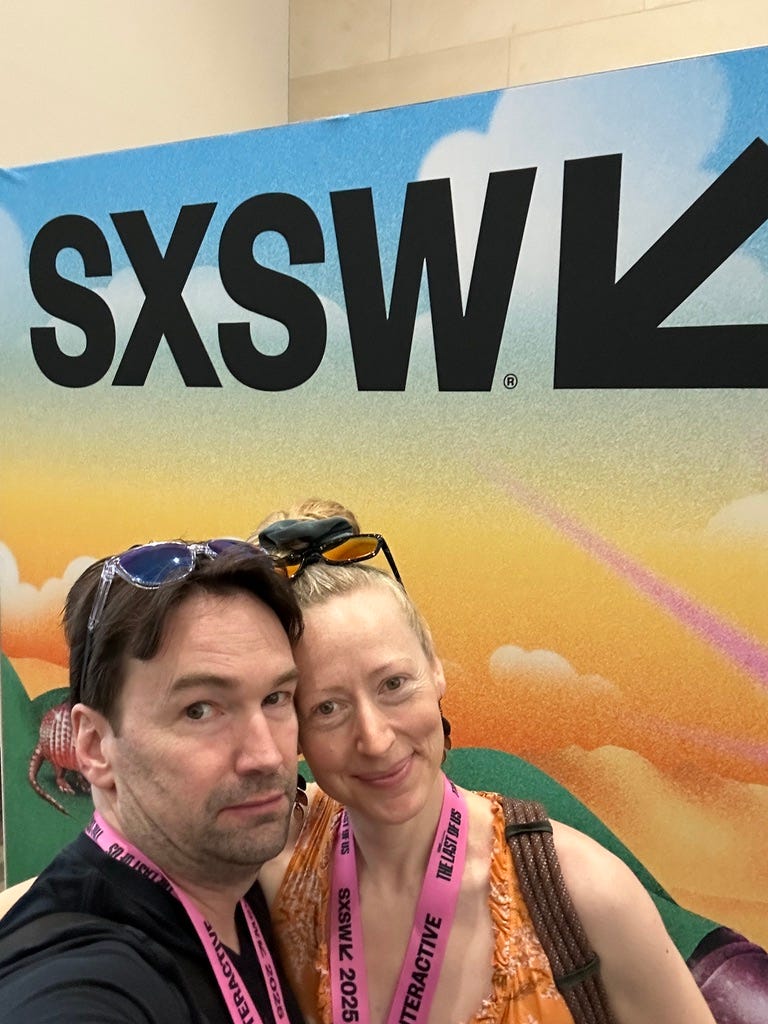


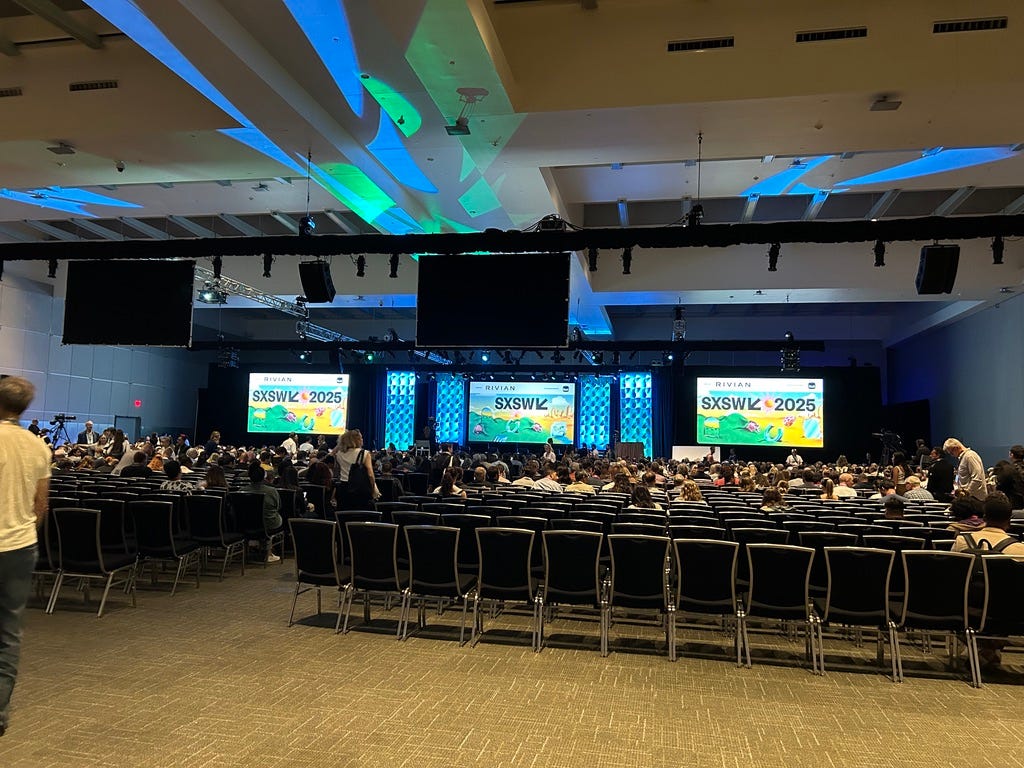




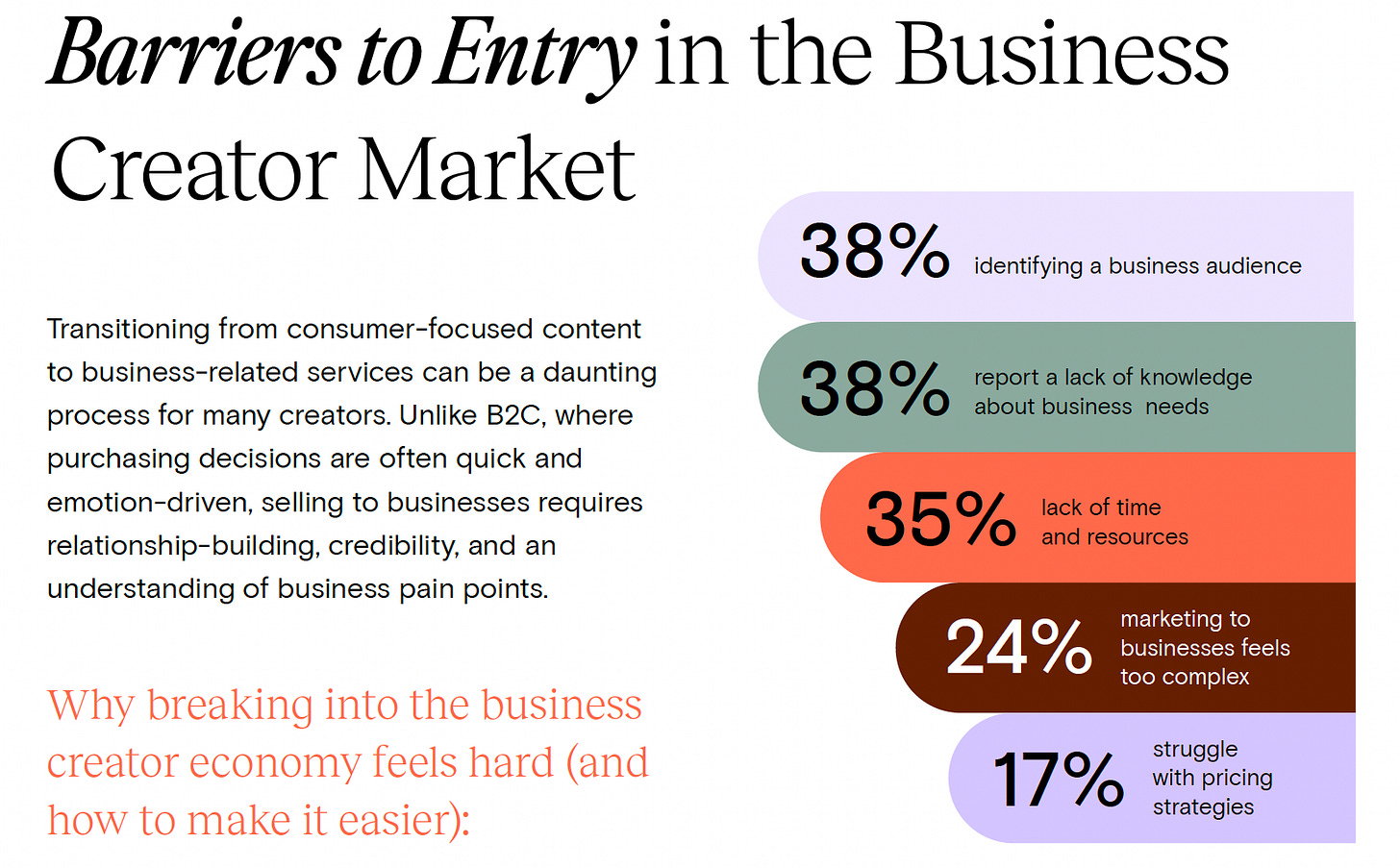
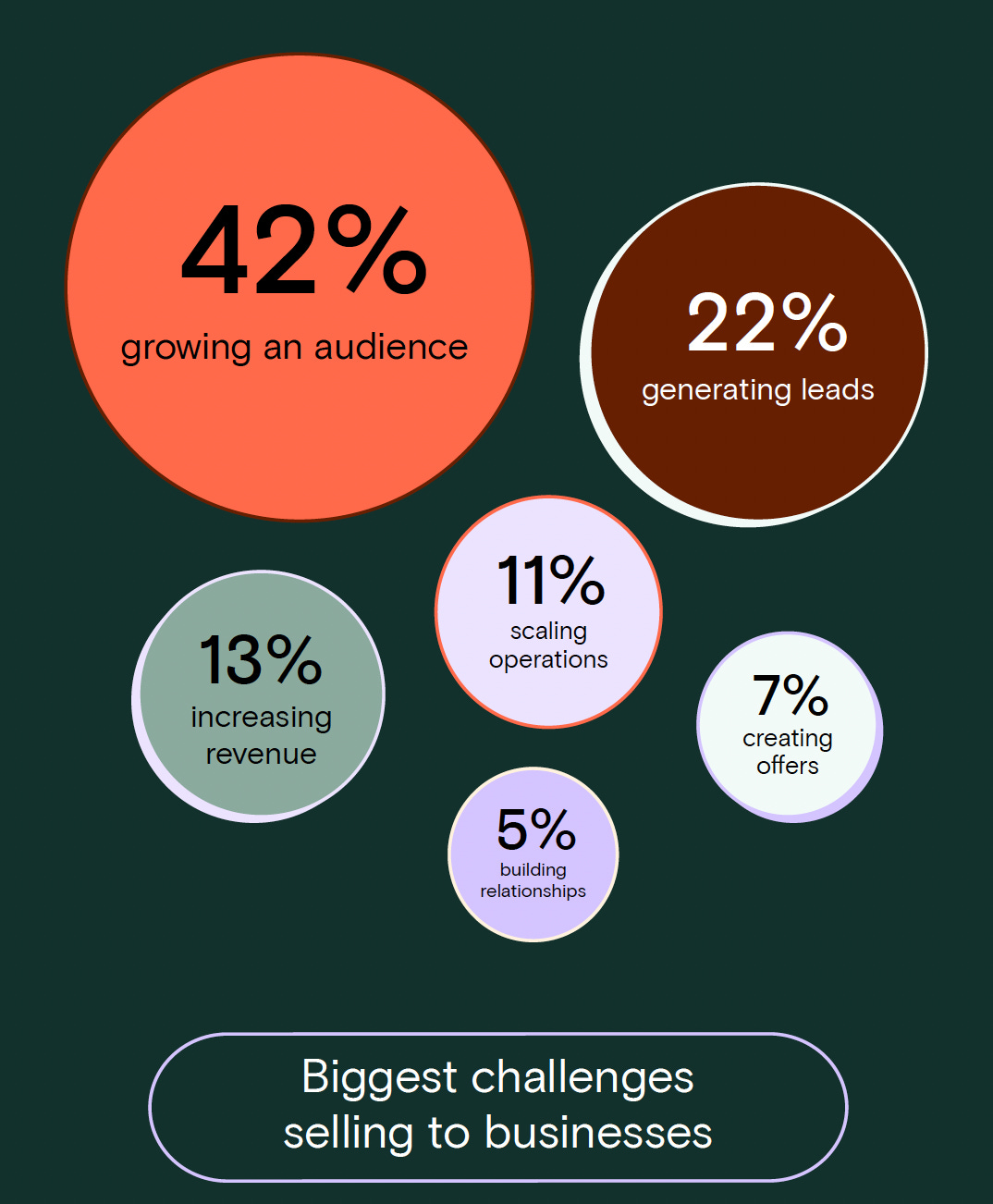
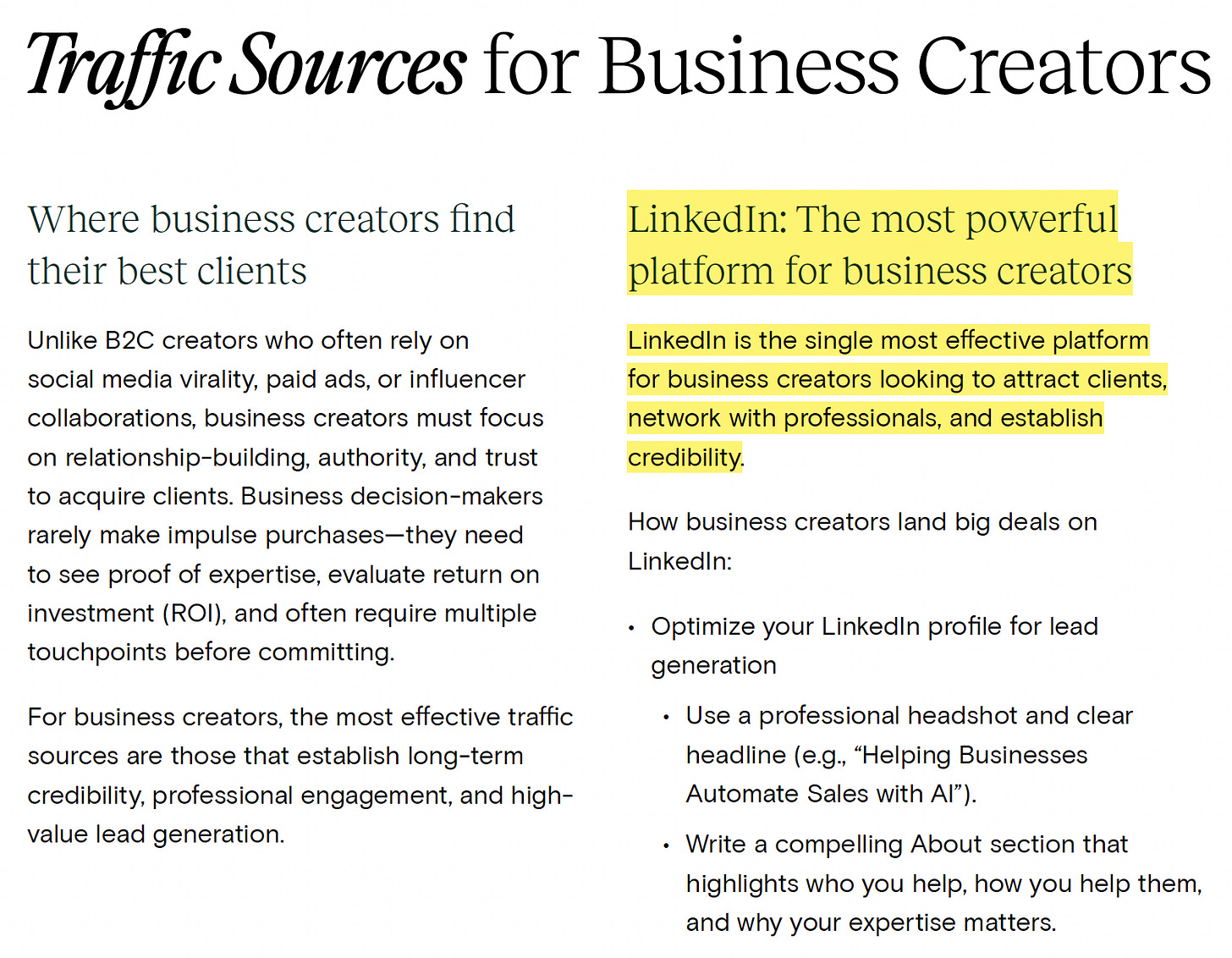
Nutshell: Organizations pay for outcomes. They pay for clarity. They pay for wisdom earned the hard way.
Favorite: Practical outcomes over performative frameworks
This is a better future path for those who can deep dive into an industry, find creative solutions and outcomes and communicate. It mainly requires fast learning and diligence, not necessarily a lifetime of experience.
I am bullish on Business Creators.